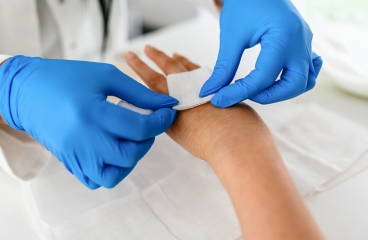Absorbable Stitches: Care Instructions
Overview

Absorbable stitches are used to close a skin wound or a cut made during surgery. You may also hear them
called dissolvable stitches. They will dissolve and be absorbed by your body as it heals.
These stitches can be used anywhere on the body and under casts or splints. If you had surgery, your doctor
may have used them below the skin and put other stitches that don't get absorbed on top of your skin.
Sometimes tape strips are used on the skin too.
In most cases, your doctor won't need to take out absorbable stitches. The part of the stitch that's under
the skin will dissolve over time. If you have a knot from the absorbable stitch on top of your skin, it will
probably fall off in a couple of weeks. But everyone is different. The timing depends on the type of stitch
you have and the size of your wound. And certain body parts can take longer to heal.
Talk to your doctor if your stitches don't go away when your doctor said they would.
Follow-up care is a key part of your treatment and safety. Be sure to make and go to all
appointments, and call your doctor if you are having problems. It's also a good idea to know your test results
and keep a list of the medicines you take.
How can you care for yourself at home?
-
Keep the area dry for the first 24 to 48 hours. After this, you can shower if your doctor says it's okay.
Pat the wound dry.
-
Don't soak the wound, such as in a bathtub or swimming pool, until your doctor says it's okay.
-
If your doctor told you how to care for your wound, follow your doctor's instructions. If you did not get
instructions, follow this general advice:
-
After the first 24 to 48 hours, wash around the wound with clean water 2 times a day. Don't use
hydrogen peroxide or alcohol. They can slow healing.
-
You may cover the area with a thin layer of petroleum jelly, such as Vaseline, and a nonstick bandage.
-
Apply a little bit of petroleum jelly and replace the bandage as needed.
-
Prop up the sore area on a pillow anytime you sit or lie down during the next few days. Try to keep it
above the level of your heart. This will help reduce swelling.
-
Avoid any activity that could cause your wound to reopen.
-
Do not touch, pick at, or remove the stitches. Let them go away on their own.
-
Leave the tape strips on until they fall off.
When should you call for help?
 Call your
doctor now or seek immediate medical care if:
Call your
doctor now or seek immediate medical care if:
Watch closely for changes in your health, and be sure to contact your doctor if:
Current as of: July 10, 2023
Content Version: 14.0
Care instructions adapted under license by your
healthcare professional. If you have questions about a medical condition or this instruction, always ask
your healthcare professional. Healthwise, Incorporated disclaims any warranty or liability for your use of
this information.